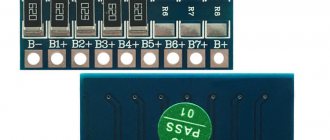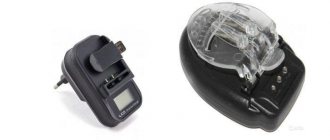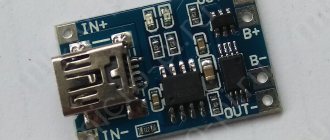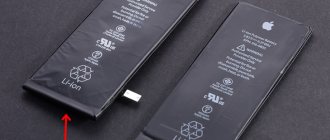How does parallel charging work?
Schematic demonstration of work:
This connection is called parallel, that is, in this case, all 4 batteries are connected in a single circuit.
Each battery has a capacity of 1300mAh and a voltage of 16.8V. With a parallel connection, the total capacity will increase to 5200mAh, but the voltage will remain the same - 16.8V.
With a series connection, the voltage increases, but the capacitance remains the same. In our case it would be: 67.2V and 1300mAh.
Methods for connecting a second battery
If we talk about installation recommendations, there are several general rules:
- The device is located outside the cabin, as it emits harmful fumes.
- Select a battery with the same capacity as the main one.
- The generator is replaced with a more powerful one or another one is installed so that the charges of both batteries are restored quickly and the generator does not fail, since the second battery requires additional power.
- For connection, choose short cables, then the batteries will work more efficiently.
Which battery and cable to choose
A power source is selected that can withstand a large number of discharge/charge cycles, since it is expected to operate in this mode, for example, gel batteries. But they also have a number of disadvantages, for example, recharging from the on-board network.
How to connect batteries to parallel charging?
The batteries are connected quite simply:
The power supply (plus and minus) is connected to the charger, as well as the balancing cable, which consists of 7 wires, this is so that 6S batteries can be charged.
It is not enough to simply connect the batteries. There are rules here, more about them below.
Rule 1. You cannot charge batteries together with different numbers of sections, large voltage differences and different types. Also, you cannot allow a large spread of capacities: you can charge 500-1500mAh, 1300 and 2200mAh batteries together, but 500 and 8000mAh batteries cannot be charged together!
That is, if you want to charge batteries in parallel, then for example, you can only connect: 4S Lipo 1300mAh and they are all discharged to approximately 3.85-4 volts.
In addition, only the following types of batteries can be charged in parallel:
- LIPO;
- LIFE;
- LI-ION.
Why stick to small voltage difference?
This is due to the fact that the batteries, when connected alternately, will try to equalize each other’s voltage. An example is communicating vessels with water. The most “full” battery will begin to supply current to the less “full” battery until they become the same in voltage.
Rule 2. This leads to one more thing: first you need to connect the power wires of all batteries, wait a few minutes (see the table of dependencies below) and then connect the balancing wires.
How long do you need to wait for the battery voltage to equalize?
The table is, of course, approximate, but reflects the full essence of the issue:
For example, if one battery is discharged by 50% (from the maximum voltage mark to the minimum), and the second is discharged by 20%, then you will need to wait about 15 minutes, since 50-20 = 30%.
What happens if you connect a charged battery and a discharged one? The answer is simple - since too much current will flow from charged to discharged, the tracks on the parallel charging board will melt, because they are not designed for such high currents.
Diode insulator
Diode isolator is a common method of charging two or more batteries simultaneously. The output current of the generator is supplied to diodes, which allow it to pass in only one direction and block its flow between the batteries.
Each battery is assigned its own diode, with which any number of batteries can be charged simultaneously. During operation, the batteries are isolated from each other and the on-board equipment cannot accidentally discharge the starting battery.
Although diode isolators appear to be ideal devices for charging two batteries, they have a significant drawback that is often overlooked.
Problems when using a battery diode insulator. Diagram 1 - Voltage on additional batteries is 12.8 volts. They will never charge. Scheme 2 - An external regulator increases the generator voltage. The voltage on the starting battery is 15.2 Volts. It's recharging. The voltage on the additional batteries is 14.2 V. They are undercharged. Scheme 3 - The external regulator increased the generator voltage even more. The starter battery will boil.
A diode can be compared to a valve installed in a water pipe. If the valve is held closed by a spring, then in order to open it, the water pressure must overcome the force of the spring. To open the diode, it is also necessary to perform additional work, which leads to a voltage drop between its input and output.
Depending on the type of diode and the ratio of its rating to the current flowing in the charging circuit, the voltage drop across the diode is 0.6-1.0 volts. Since a difference of tenths of a volt has a significant impact on the speed and quality of charging the battery, the voltage drop across the diodes makes the charging system inoperable.
A standard voltage regulator installed inside an alternator measures battery voltage at the alternator output terminal rather than at the battery itself. If a diode appears in the charging circuit, the regulator “thinks” that the battery voltage is 14.2 volts, although in fact it is 13.6 volts.
If this voltage drop is not compensated for, the regulator will shut down the generator long before the batteries are fully charged. The charging time will increase several times, the batteries will be chronically undercharged and suffer from sulfation.
Almost always the best solution for already installed diode isolators is to throw them away and replace them with a charging relay. If you don't want to do this, you can install a remote voltage regulator or Alternator to Battery Charger from Sterling Power.
These devices take control of the operation of the generator from the built-in voltage regulator, monitor the voltage on the batteries and increase it, taking into account the drop in the diodes. In addition, they charge batteries using a four-stage algorithm, which is much more efficient than charging directly from a generator.
What current can be used to charge batteries in parallel charging?
My parallel LiPo charger (link below) works with currents up to 40 amps:
It also has a fuse:
and in case of overload, it will burn out and save the board tracks from burning out.
Since such charging has a parallel connection, mAh is summed up, in our case, if we place 3 batteries of 1500mAh each:
then we will be able to charge with a current of 4.5 amperes, since in such charging you need to charge with currents of 1C - 4500mAh is 4.5 A. The charger will “see” these batteries as one single whole. As you can see, this board has a very large headroom.
Charging device
A common drawback of the described devices is charging parallel-connected batteries using the same algorithm. But since the starting and traction batteries accept charging differently, one will regularly be overcharged while the other will be undercharged. The difference will increase if a large-capacity traction battery is connected to a relatively small starting battery. The only way to solve this problem is to install its own voltage regulator for each battery and adjust it to the type of battery being used. This is easy to do if two generators are installed.
In electrical systems with one generator, a special charging device is required, which is connected between the starting and traction batteries. The device turns on and charges the second battery using a four-stage algorithm as soon as the generator starts working. Thanks to this, different types of batteries can be used simultaneously. Some models allow you to work with two different voltages - receive 12 volts at the input and output 24 or 36 volts.
Unlike external DC-DC regulators, chargers do not increase the voltage on the alternator and can be used on engines with an ECU and on vehicles with alternators that comply with EURO5 / EURO6 standards
Ask a question,
and get advice on electrical equipment for a boat, yacht, motorhome or camper
About parallel charging
I use this parallel charging:
Very high quality plastic and decent weight, soldering is clean. The kit includes a balancing cable and the board itself.
Photos
Remote switch
A remote battery switch is a power relay that is installed next to the battery, and its activation button is placed in a location convenient for the user. This arrangement reduces cable length, cost, weight and voltage drop and is often more cost-effective than a mechanical battery switch.
Criteria for selecting a remote switch:
- Short-term and continuous load must correspond to the power of the current source
- Status indicators on the body and on the on/off button
- A bistable relay is used as an actuator, which consumes current only at the moment of switching, but not in the closed state
- Fireproof design for installation in gasoline engine compartments
- Protection class IP66-IP68
To the common circuit
This method of connecting a backup battery to a car is considered the most optimal, as it involves the use of special “junctions”. These unique relays are capable, in manual or automatic mode, of alternately (as the charge is depleted) connecting or disconnecting the main and backup power sources to the vehicle’s on-board network to recharge.
The only drawback of this type of connecting an additional battery to a car is the high cost of the devices, which are almost as expensive as a new battery. But the “decoupling” will help the driver manually select a working battery, as well as receive detailed information about the charge level of each power source.
Second battery: to have or not to have?
As you can see, it is quite possible to connect a second battery. You just need to think in advance what equipment you need to connect, evaluate your financial capabilities and estimate whether there is enough space in your car for new equipment.
With financial investments and proper installation of equipment, you will get an excellent circuit of two or more batteries.
And then you can use your car to go camping, fishing, on a long trip, etc. without any problems. Everything will be ready to connect additional equipment.
Which type of battery to choose?
For the additional battery, various batteries can be used: WET, GEL or AGM type. The first battery is based on liquid electrolyte, and the other two are gel batteries, but of different designs.
WET
Advantages:
- Low price;
- It is easier to select one similar to the standard device.
Flaws:
- Rapid wear;
- The need for a strictly vertical location to prevent short circuit;
- If you have acoustics with a subwoofer, it allows for a voltage drop, which significantly spoils the sound quality;
- Installation inside the cabin is not allowed;
- Long lasting full charge.
GEL
Advantages :
- Low internal battery resistance;
- High resistance to deep discharges;
- Can be installed regardless of location in space;
- Harmless for installation inside the car.
Flaws:
- It is necessary to look for special chargers of good quality, which is quite difficult today;
- When the temperature of the environment decreases, it is not capable of delivering large currents;
- Great price per unit.
AGM
Advantages:
- It is highly resistant to voltage drops, which makes it best for acoustics with a subwoofer;
- Fast charging;
- High resistance to deep discharge;
- There are no harmful fumes during operation, can be installed in the cabin;
- The housing is sealed at a good level, which allows you to place the battery directly next to the amplifier and acoustics, thus reducing the length of connecting cables and the internal resistance of the circuit as a whole;
- Can be located in any position relative to the vertical.
Flaws:
- Despite the lower price than its gel-type cousin AGM, it is still an expensive pleasure for the average car enthusiast;
- It is difficult to find chargers, since modern car stores do not have them; only “underground” devices are available from online stores or sales of self-made, homemade ones from under the counter.
This video describes in detail the advantages and disadvantages of different types of batteries, and their use as additional power sources:
When will a second battery come in handy?
On our roads there are a large number of SUVs equipped with an electric winch. In addition, the car is equipped with an alarm system and an audio system. All this drains the battery faster. For such machines, a second battery becomes an indispensable addition.
To understand whether it is worth installing a battery in a car, you need to perform a small calculation. An ordinary car has a device whose capacity is in the range of 55-65 Ah. The standard power of such a device reaches 4 kW. Moreover, car appliances, as well as other standard energy consumers, take approximately 2 kW.
When additional electrical devices are installed in the car, the total power of which exceeds 2 kW, it probably does not hurt to think about connecting an additional second battery. You can find out how much power additional devices consume by carefully studying their technical characteristics.
By the way, the second battery will fit perfectly in the trunk. There's plenty of room for him.
Choosing a location to install the second battery
In any passenger car there are only three conventional zones where you can put a second battery:
- Engine compartment.
- Salon.
- Luggage compartment.
Let's start, perhaps, with the salon, since they almost always say about this place that it is absolutely forbidden. Indeed, if you plan to use a classic with liquid electrolyte as a second battery, then, of course, you should not install it in the cabin. Evaporation and all that... But what about more advanced power sources - gel ones, for example? Many people have similar batteries right under their feet in the form of uninterruptible power supplies for computers. So why can’t a battery with the same manufacturing technology be installed in a car? Yes you can. If there is room, of course.
Under the hood of many cars, it’s not like there’s a second battery that won’t fit into a matchbox. That’s why many car owners, when recommending this option, twist their index finger at their temple. Yes, this option does not suit them. But there are also cars with a lot of free space under the hood. And if there is a better place for a second battery, then it is here. But not always.
So, if you plan to connect the second battery through an automatic switching device, then the location of its installation is not very critical. If two batteries are connected directly in parallel, then the distance between them plays a huge role. The fact is that they can only be connected directly with wires of an impressive cross-section. Otherwise, there will be significant voltage drops, heating of power wires and even a fire. And if the second battery is installed under the hood, then connecting it with normal wires is much easier than pulling these into the back of the car.
Actually, the third place to install a second battery - the trunk - is not the best option. But sometimes there is simply nowhere else to go. In such cases, the battery must be connected only through a switch or using very thick wires.
It should be understood that the cross-section of the positive wire running from the main battery to the starter (the most loaded) may not be enough when installed in the trunk. It's because of the distance. Under the hood there is only about half a meter from the battery to the starter. But from the trunk, the length of the wire when hidden somewhere under the trim can be about 3-5 meters. Accordingly, the resistance of this wire will increase by the same amount, as well as the voltage drop across it. This is fraught with voltage drops and excessive heating of the wire.











